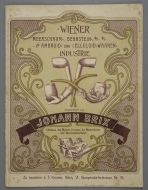Catalog of a meerschaum manufacturer
January 2006

The manufacturer's catalog is an extremely important source of information on the development of the pipe over time. In the catalog, the manufacturer shows his assortment as a plain list of shapes and types available at that moment, usually without comment. For us now, this gives a great insight into fashion and its process of change. This catalog, published by Johann Brix from Vienna, introduces us to the world of the meerschaum pipes at the turn of the for-last century. The catalog shows 376 pipes and six pipe stems on 21 pages. Only 68 pipes out of that offer are intended for tobacco, two are water pipes and all others are meant as cigar holders. This shows that during that period the meerschaum tobacco pipe was strongly pushed into the background by the cigar holder. The latter article, as a matter of fact, has become very ordinary. Pretty ladies' busts, single horses or pairs, dogs and other animal figures are shown. From the catalogue it is clear that Brix was a manufacturer of luxury serial work, a fashion that had become so plain-vanilla that we could no longer find any spectacular uncia’s. In addition to this decorated item, the simple cigarette tip has become commonplace. The choice was very wide. The tobacco pipes are shown at the very back of the catalog, clearly a sign of their decreasing popularity. The choise in sizable tobacco pipes is then limited to the fashionable egg bowl or the traditional high Hungarian. The hinged covers with which these pipes are mounted display simplicity, fitting in with the bourgeois and common nature of the Brix range. In addition to this old-fashioned ware, a few cased pipes have new bowl shapes such as the Dublin and the billiard. They represent the fashionable element and are intended for the more sophisticated smoker. It is clear that Brix served a specific market segment, but it also appears that around the year 1900 the taste of the meerschaum pipe wasmostly conventional and popular.
Amsterdam Pipe Museum APM 21.273
Permalink